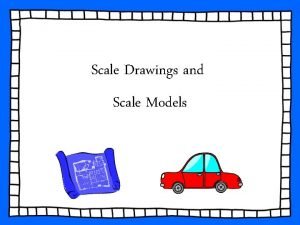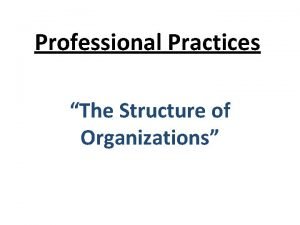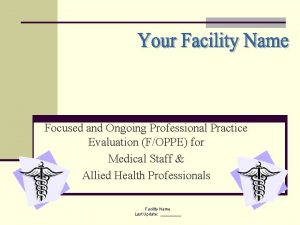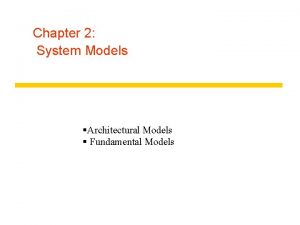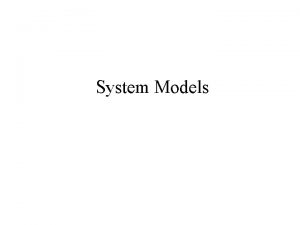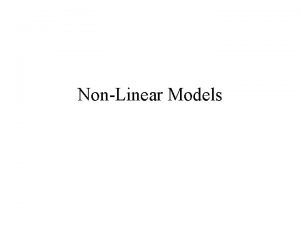CHAPTER 15 PROFESSIONAL PRACTICE MODELS DEFINITIONS Professional Practice




















- Slides: 20

CHAPTER 15 PROFESSIONAL PRACTICE MODELS

DEFINITIONS • Professional Practice Models (PPMs) – conceptual framework and philosophy of nursing within an organization • Care Delivery Models – Operational mechanisms by which care is actually provided to patients and families

PROFESSIONAL PRACTICE MODELS • Mission Statement • Vision Statement • Values Statement • Philosophy • Policies and Procedures

POLICIES • Serves as guides • Help coordinate plans • Control performance • Increase consistency of action • Should be written • Usually are general in nature • Refer to all employees

WHAT DO NURSES HAVE TO DO WITH POLICY? • EVERYTHING! • Nurses can be involved at all stages of the policy process. • Involvement in policy is a form of advocacy for patients and populations. • Nurses are experts in caring for patients. • Nurses are uniquely qualified to assume important roles in policy. • Nurses are at the forefront of quality and safety. • If we are not at the policy table, then someone else will be making decisions for us.

PROCEDURES • Provide step-by-step methods • Are written in detail • Provide guidelines for commonly occurring events • Provide a ready reference • Guide performance of an activity • Should include the following: • A statement of purpose • Identification of who performs activity • Steps in the procedure • A list of supplies and equipment needed

CLINICAL PROTOCOLS • Structured Care Methodologies (SCMs) • Critical Path

HEALTHY WORK ENVIRONMENTS • Effective leaders at all levels of the organization • Professional development opportunities • Staffing structures that consider nurse competencies, patient needs, and teamwork • Interdisciplinary collaboration • Empowered, shared decision making • Patient-centered culture/culture of safety • Quality improvement infrastructure, evidence-based practice • Visible acknowledgment of nursing’s unique, valued contributions (e. g. , professional practice model, vision/mission/philosophy statements)

TYPES OF CARE DELIVERY MODELS • Traditional Nursing Care Delivery Models • Private Duty Nursing • Group Nursing • Total Patient Care • Functional Nursing • Team Nursing • Primary Nursing • Case Management

EVOLVING MODELS • Patient and Family Centered Care (PCC) • 1. Respect for patient preferences, values, needs • 2. Information, education, communication • 3. Coordination, integration of services • 4. Emotional support • 5. Physical comfort • 6. Family/close other involvement • 7. Continuity, safe transitions between care settings (e. g. , hospital to home) • 8. Access to care and services

INNOVATIVE AND FUTURE MODELS • Traditional Care Model • Patient-Centered Medical Home (PCMH) • Customer Satisfaction • HCAHPS • CMS

LEADERSHIP AND MANAGEMENT IMPLICATIONS • Nursing care delivery has become more complex • Inter-professional team collaboration models • Nurse Leaders in perfect position to lead the change in care delivery design • Challenges for patient care in future is massive • Forces and pressure outside of professional nursing influence care models

HEALTH POLICY PROCESS EXAMPLE • As a nurse in an emergency department, you’ve noticed increasing numbers of mentally ill seeking services, which reflect recent policy changes that decreased funding for treatment. You join a coalition made up of other healthcare professionals and members of the National Alliance for Mental Illness (NAMI). A working group is formed to propose a policy for providing better services for those with mental illness in your community and state. 1. Define the problem. The ED has seen a 400% increase in visits by individuals with mental illness in the past year. Funding to local clinics for treatment was decreased by almost $600, 000 in the previous year. The mentally ill in the community are not receiving the treatment needed to stay as healthy as possible, and instead are seeking treatment at the ED.

HEALTH POLICY PROCESS EXAMPLE 2. Gather information. What else do we want to know about the issue? Why was the policy changed to reduce funding for treatment? Who are the stakeholders involved in this problem? 3. Establish the policy theory. What policy conceptual model best fits the approach we want to take? For example, incremental theory suggests we should aim for small changes in policy that gradually get us to where we really want to be. 4. Evaluate existing policy. What is the existing policy? Why has it resulted in decreased services for the mentally ill? Can we build on this policy or propose a new one?

HEALTH POLICY PROCESS EXAMPLE 5. Develop alternatives. Consider 2 to 3 or more policy options. 6. Select “best fit. ” Which policy alternative are we going to send forward? Which alternative works best for what we want to do? Given the political environment, which option is most feasible? 7. Trade off costs and benefits. What will we lose with this policy? What will we gain with this policy? How much $$$ are we proposing it will take? What is the $$$ benefit of providing services to mentally ill in the community and reducing ED costs?

HEALTH POLICY PROCESS EXAMPLE 8. Matrix it. Create a visual representation that includes each item in the policy and how it will be implemented in practice including revenue and costs. 9. Describe the implementation. How will this policy be implemented? Who will implement it? Where does the money go? Who will monitor and evaluate the implementation? What outcomes are to measured? 10. Consider political strategy. To which legislative body are we proposing the policy? Who will speak for us? What legislator may be interested in this issue? Identify a champion. Plan a “mental health day” at the state legislator. Gather other individuals to participate in the coalition and speak publicly about the issue.

HEALTH POLICY EXAMPLES • HIPAA • Children’s Health Insurance Program (CHIP) • HRSA nursing workforce development program • Local ordinances for clean air and water • Gun control legislation • Tobacco-free businesses and facilities • Comprehensive Addiction & Recovery Act (CARA) 2016 • Mandatory immunization requirements • Healthy People 2020 • AND MANY MORE!!!!!

WAYS TO GET INVOLVED IN INFLUENCING POLICY • Vote! • Join a nursing professional organization. • Take on a leadership role in a nursing profession organization. • Get involved in a policy council at your workplace • Make a suggestion to your nurse manager. • Write your local, state, and federal government representatives. (Gary Herbert) • Know your local, state, and federal government representatives. • Write letters to the editor.

WAYS TO GET INVOLVED IN POLICY • Post to social media: Facebook, Tweeter, blogs, etc. • Partner with others. • Join a coalition. • Collaborate with other healthcare professionals • Sit on community organization boards. • Run for local or state office. • Attend nurses’ day at the state legislature.

IN SUMMARY • "Nurses can influence community health, public policy and the nursing profession on many levels. Advocacy can be displayed in many ways, such as writing a letter to your representative, providing a presentation at a community event, or sharing stories told by patients about the barriers to healthcare they encounter regularly. Advocacy is integrally tied to what nurses do. We care about the profession, patients and families and can help influence decisions to improve outcomes. ”
 Semi modals
Semi modals Chapter 19 matching words with definitions
Chapter 19 matching words with definitions Chapter 13 sentence check 1 answer key
Chapter 13 sentence check 1 answer key Models of case work
Models of case work Practice 8-1 exploring exponential models answers
Practice 8-1 exploring exponential models answers 7-7 practice scale drawings and models
7-7 practice scale drawings and models Remedial model in social group work
Remedial model in social group work Exploring exponential models
Exploring exponential models Exponential growth and decay examples
Exponential growth and decay examples Weather model of reflection social work
Weather model of reflection social work Scale drawings and models
Scale drawings and models Scale drawings and models
Scale drawings and models Professional practice days
Professional practice days Structure of organization in professional practice
Structure of organization in professional practice Finance and accounting in professional practice
Finance and accounting in professional practice Professional nursing practice: concepts and perspectives
Professional nursing practice: concepts and perspectives Professional business practice
Professional business practice Model of professional nursing practice regulation
Model of professional nursing practice regulation Focused professional practice evaluation
Focused professional practice evaluation Enhancing professional practice
Enhancing professional practice Danielson framework components
Danielson framework components











